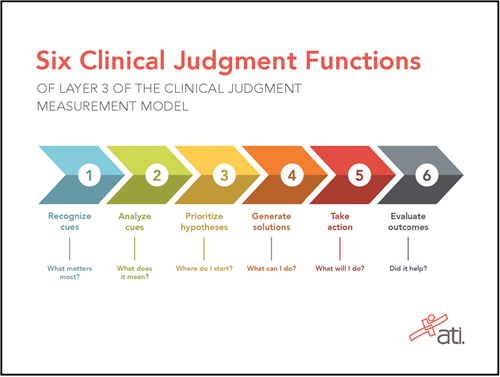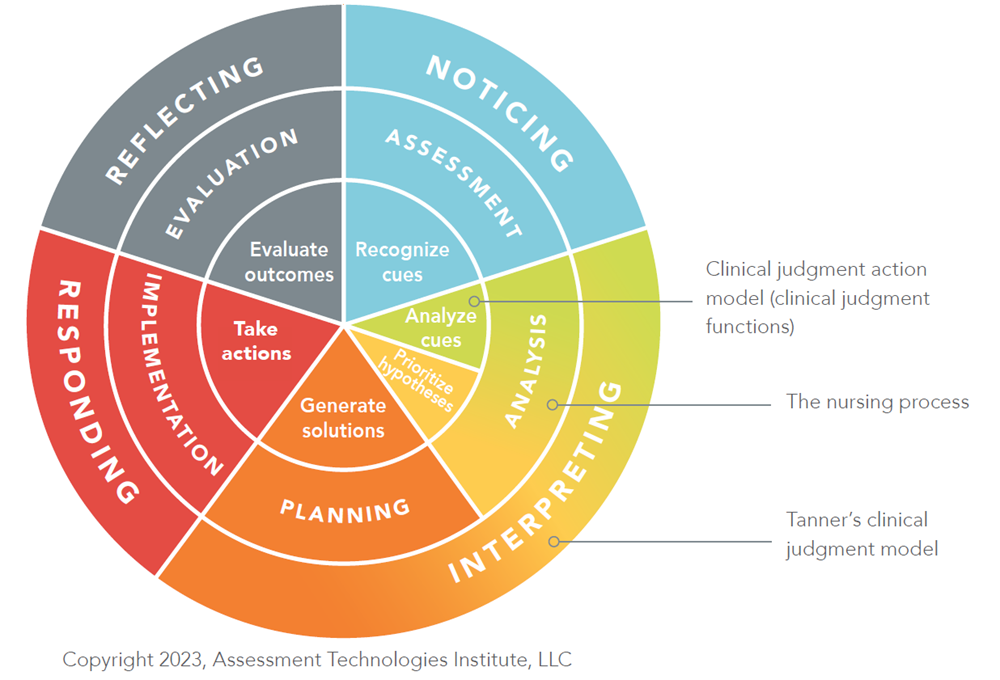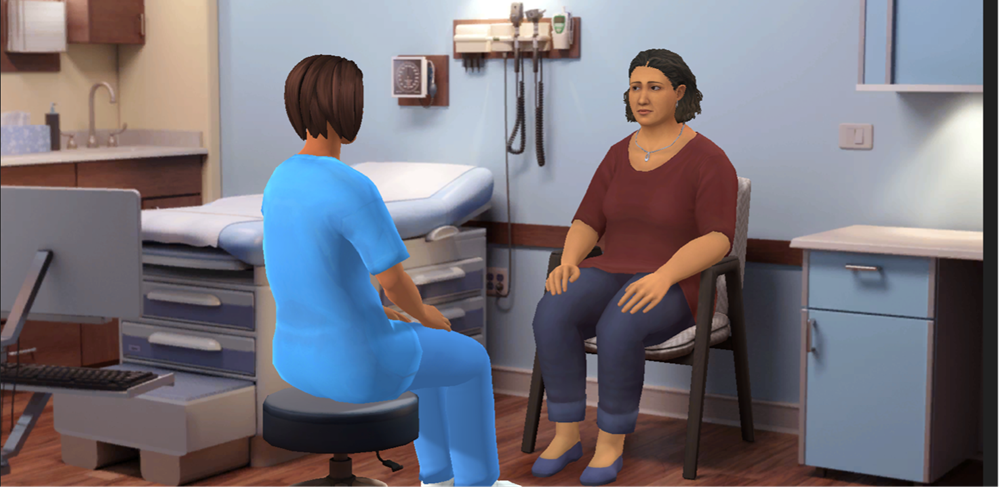Teach nursing students to analyze cues using interactive tools
Teaching nursing students the second function in clinical judgment: analyzing cues
As nursing students develop clinical judgment, they must learn to accurately analyze cues they observe in client presentations. The ability to analyze cues is the second function identified in the clinical judgment progression developed the National Council of State Boards of Nursing (NCSBN).
Clinical judgment is an outcome of critical thinking and decision making, usually observable by a nurse’s actions. The six steps to developing clinical judgment, depicted below, involve a repetitive process that the nursing student moves through when interacting with every client. The process is iterative, meaning the student can gain new information or cues while assessing or treating the client. This new information can prompt the student to return to a previous function and then move through the process again, continuously re-evaluating.
Help students learn to analyze cues by incorporating interactive tools

This article is the second in a series that explores the development of clinical judgment in nursing students. Find the first article, focused on recognizing cues, here. The series examines each of the clinical judgment functions and identifies resources faculty can incorporate to help students develop these skills. (The ATI Nurse Educator blog has published numerous articles about developing clinical judgment. View the list here.)
Analyze cues to understand a clinical presentation
“Analyzing cues requires a nursing student to consider the multiple things that could be occurring in or affecting the client,” said Amanda Jamison, Lead Product Training Specialist for ATI Nursing Education. During an ATI webinar focused on cues and clinical judgment, she explained that the process of analyzing cues requires organizing and linking cues to the client’s clinical presentation by reflecting on questions such as:
- Which of the client’s conditions is/are consistent with the identified cues?
- Do the cues support or rule out any specific condition?
- Why is a particular cue or subset of cues concerning or worrisome?
- What additional information would help determine the significance of a cue or set of cues?
“Remember, the focus of teaching how to analyze cues is the student’s ability to link recognized cues to a client’s clinical presentation and to establish probable client needs, concerns, or problems,” Jamison said.
The ATI Guide for Clinical Judgment is an excellent resource for faculty as they teach cue analysis. The purpose of the ATI Guide for Clinical Judgment is to assist nurse educators in the development and implementation of learning materials to prepare students to pass the NCLEX and enter practice. For example, the guide may be used as a framework for creating learning activities such as scenarios for simulation, writing unfolding case studies, and developing test items.
Table 2 in the ATI Guide for Clinical Judgment provides an overview of clinical judgment functions and expected responses and behaviors. The portion of the table focused on analyzing cues states that as a student develops this skill, the expected responses and behaviors are to:
- compare client findings to evidence-based resources and standards of care
- analyze expected and unexpected findings in health data
- anticipate illness/injury and wellness progression
- identify client problems and related health alterations
- analyze client needs
- identify potential complications
- identify how pathophysiology relates to clinical presentation
- identify data that is of immediate concern.
Integrate the nursing process with clinical judgment functions
The image below is a representation of the core concepts in the ATI Guide for Clinical Judgment. It depicts the relationship of approaches that foster this essential skill: Tanner’s Clinical Judgment Model, the nursing process, and the Clinical Judgment Action Model (CJAM). The CJAM, developed by NCSBN, connects what is measured on the licensure exam to what is taught in nursing education.
“When nurses analyze cues, they are connecting or linking the cues in the client’s assessment that they recognized and are considering,” Jamison said. “The nurse is thinking about what they could mean, what they may be, and what problems may be present.”

Bring learning to life with interactive digital experiences
To teach these concepts effectively to today’s nursing students, it is helpful to bring these principles to life. “This is exactly what ATI did by developing the Engage Series, a digital learning solution that incorporates knowledge acquisition, knowledge retention, remediation and review — all in one place,” Jamison said.
As of fall 2023, the Engage Series contains 4 solutions: Engage Fundamentals, Engage Mental Health, Engage Community & Public Health, and Engage Adult Medical-Surgical. Jamison used content from Engage Mental Health to illustrate how the innovative, interactive features of the Engage series teach cue analysis and deepen overall student learning.
One of the lessons in Engage Mental Health focuses on establishing therapeutic relationships. The image below is a screen capture from one of the many videos in this resource.

“Students choose responses to the client based on what they recognize,” Jamison continued. “They may miss a cue or analyze the situation incorrectly, and there are consequences to that — just like in real life.”
In the end-of-life module in Engage Mental Health, students learn about caring for dying patients and their families, and about the grief process. Content includes the nurse’s role and responsibilities when caring for a client who is dying and the actions that are required by the nurse after a death occurs.
“Many students never learn these things until they have graduated and are working,” Jamison said. “We want students to learn about these tough subjects in a safe place, where they also learn about self-care and how to support themselves and others.”
This lesson helps students learn to analyze their own personal cues signaling effects such as occupational stress and conflict, which are common nursing experiences. Engage Mental Health includes interactive content depicting a post-death debrief among nursing and ancillary staff. “This is such an important part of the healing process, but it is often forgotten about,” Jamison noted.
All modules in The Engage Series were developed by nurse educators using current evidence-based information and resources. The content incorporates key assessment tools used by nurses in the clinical setting. For example, in the Role of the Nurse lesson, students learn how to gather essential information from a client who may have maladaptive alcohol use behaviors.
“Nurses need to recognize and analyze multiple cues in order to make appropriate judgments and decisions,” Jamison said. “The Role of the Nurse lesson includes written information and interactive experiences that educate nursing students about resources such as the CAGE assessment, used to identify potential alcohol abuse.”
Active learning experiences helps embed understanding
The Engage Series provides active learning activities throughout the delivery of the evidence-based content. Each module provides quizzing followed by summative review questions at the end of the lessons. In addition, branching logic is built into all virtual applications and simulations. “This really enhances the learning activity and helps students develop much deeper understanding on important concepts,” Jamison said. “And all lessons are structured according to the six clinical judgment functions established by the NCSBN.”
Engage Mental Health features:
- 22 lessons across 4 units (Foundations of Mental Health Nursing; Building Nurse-Client Relationships; Social, Emotional, and Behavioral Concerns; and Nursing Practice for Clients with Mental Health Disorders)
- embedded videos depicting nurse-client interactions
- attention-grabbing content with interwoven multimedia, graphics, and videos
- hands-on practice with active EHR documentation
- audio podcasts delivered by expert nurse educators
- dynamic and meaningful activities that help students apply their learning.
Additionally, Engage Mental Health promotes the development of therapeutic communication skills, helps students recognize underlying biases and fears, and prepares students for clinicals and professional practice by exposing them to realistic client presentations of mental health conditions.
“ATI solutions work together, informing one another, reinforcing concepts, and solidifying ideas,” Jamison said. “We help students learn and improve. We help them apply what they learn through testing, which predicts their ultimate success on NCLEX and their transition into safe and effective nursing practice.”

